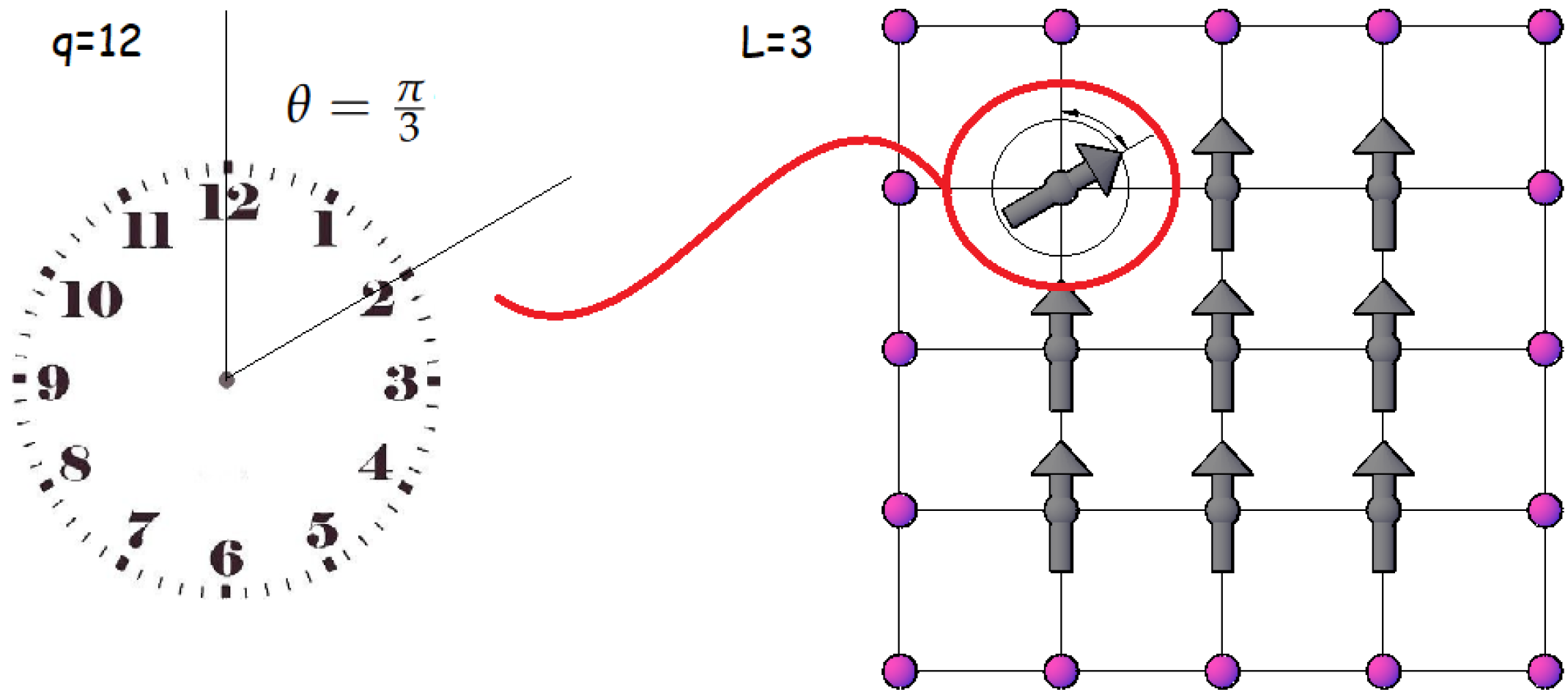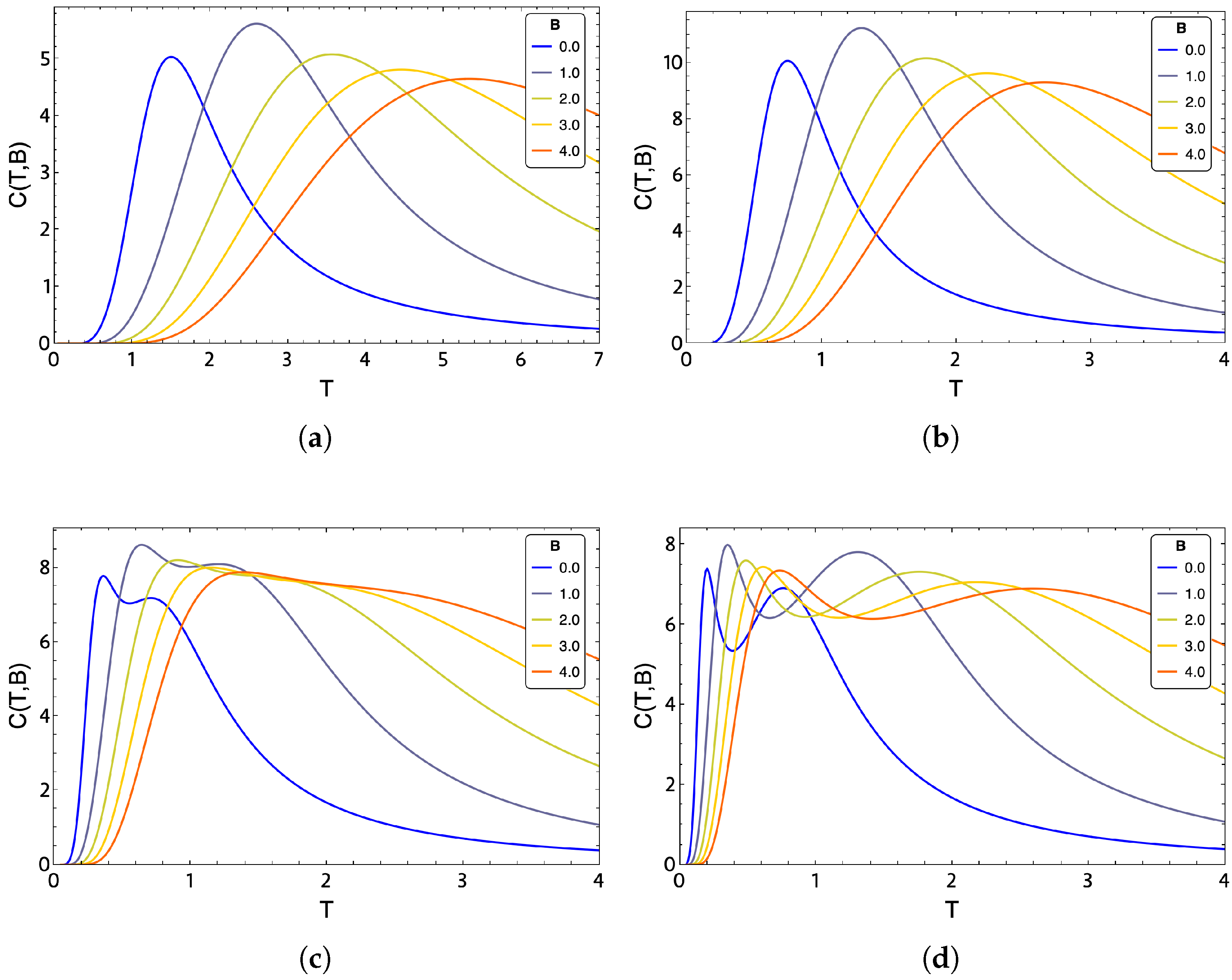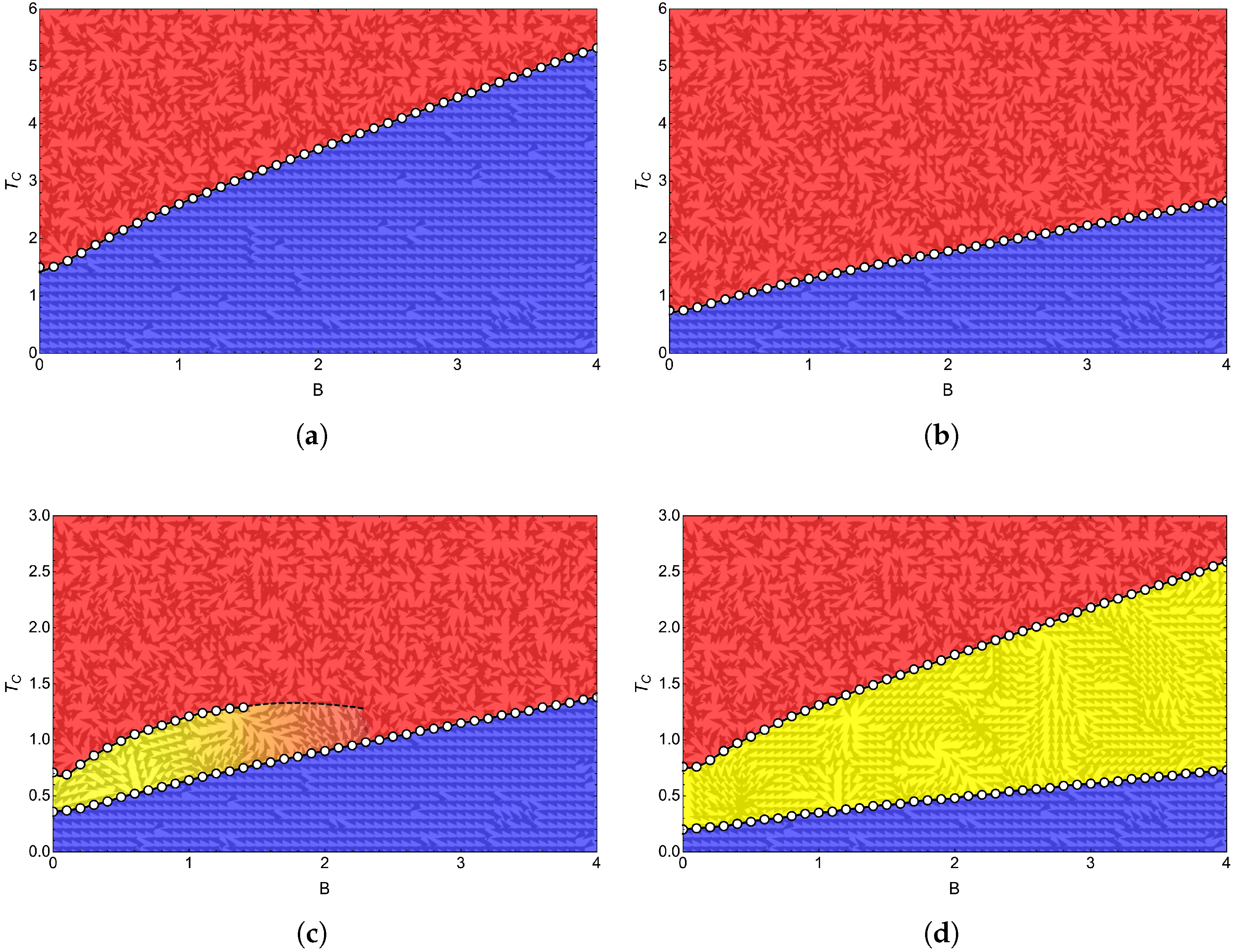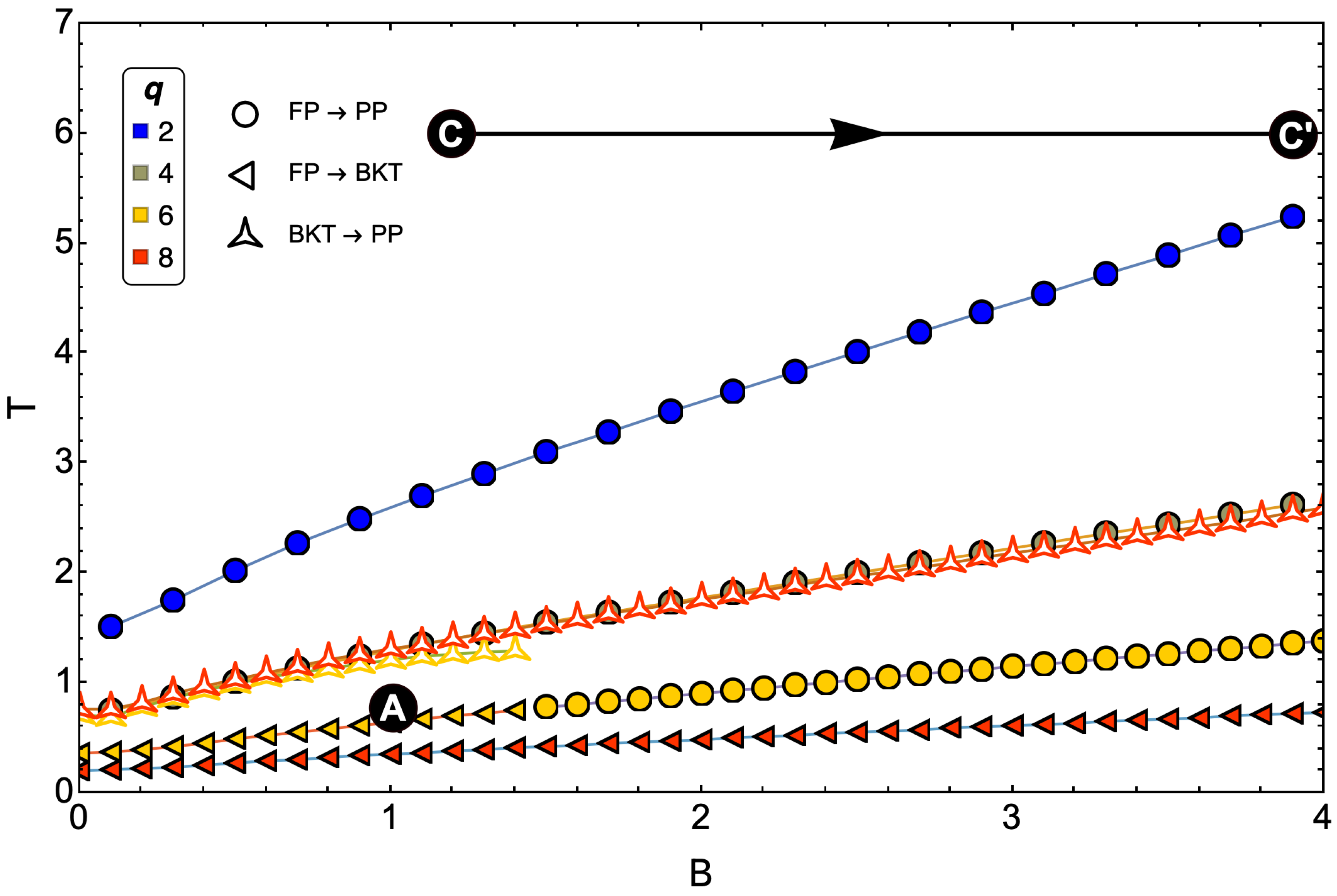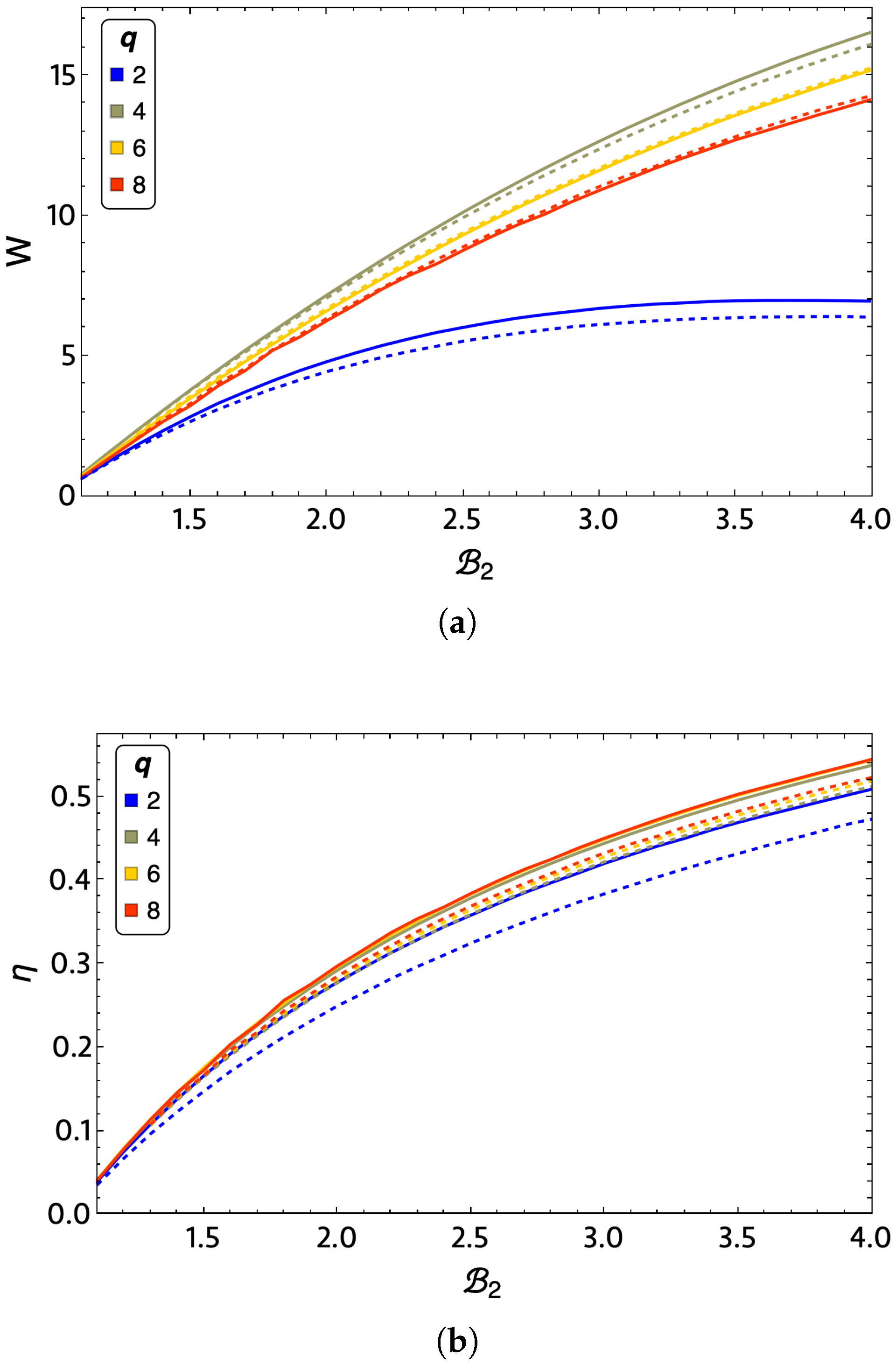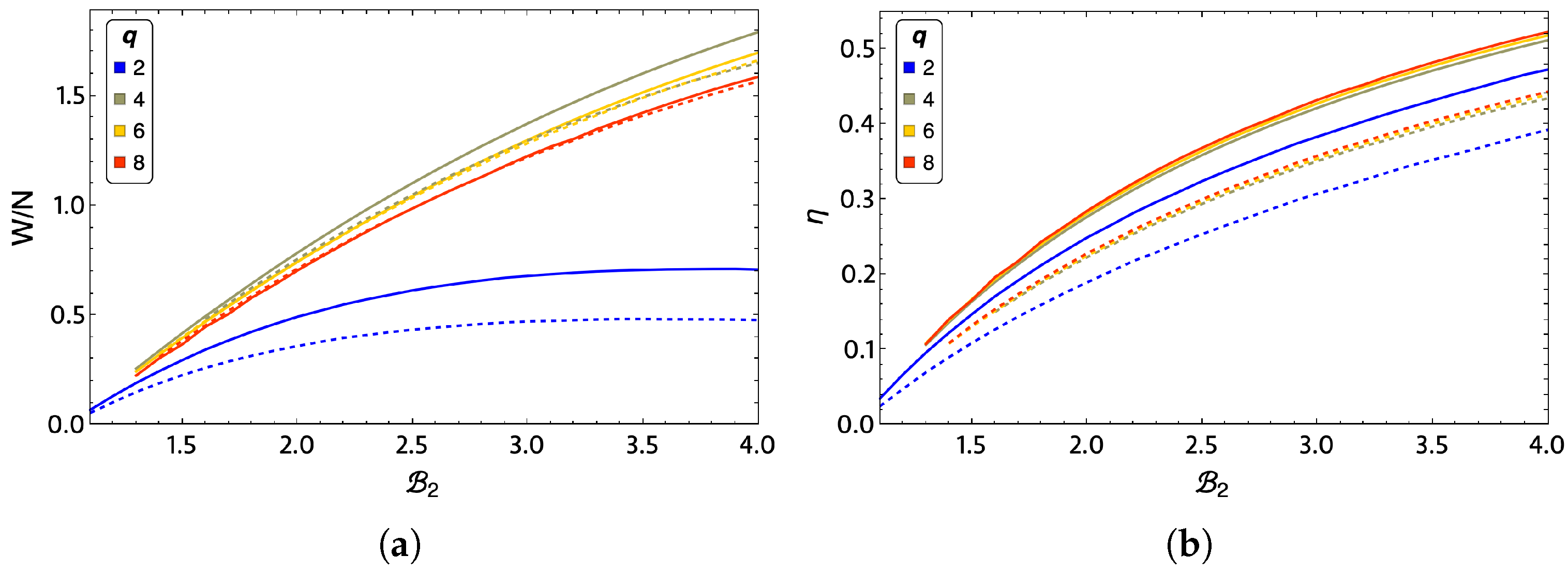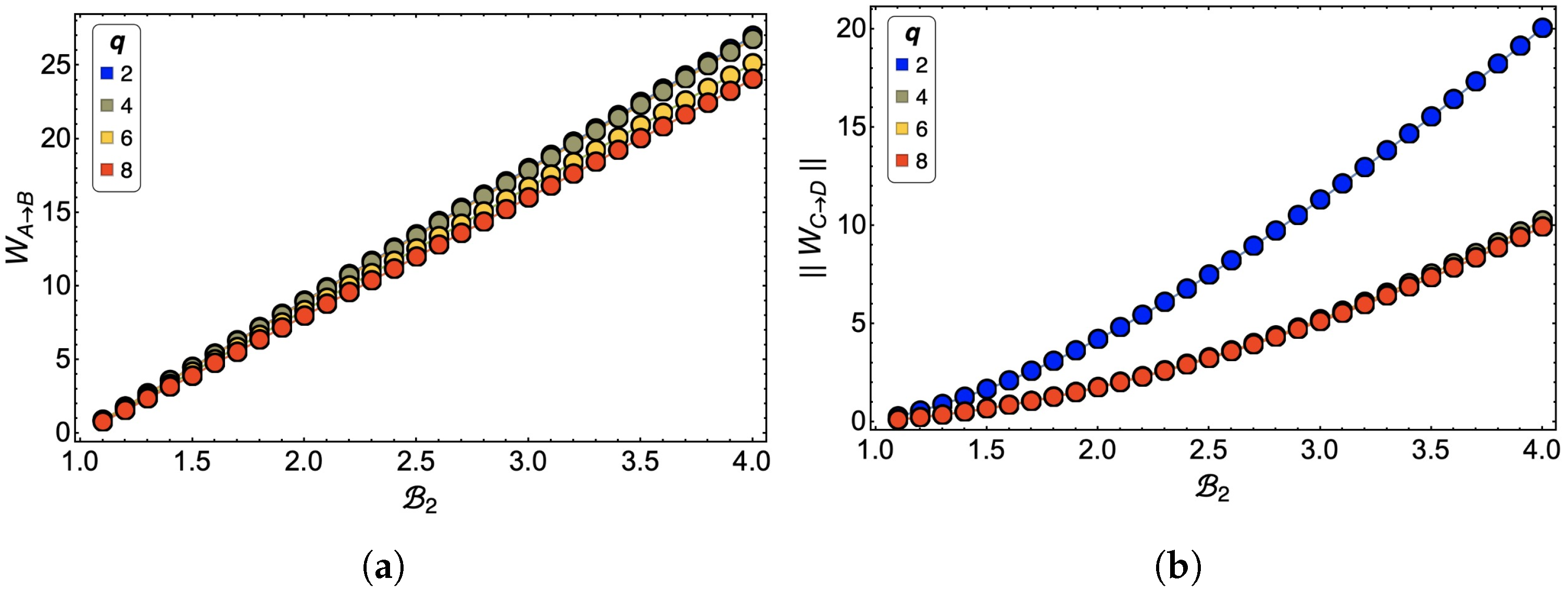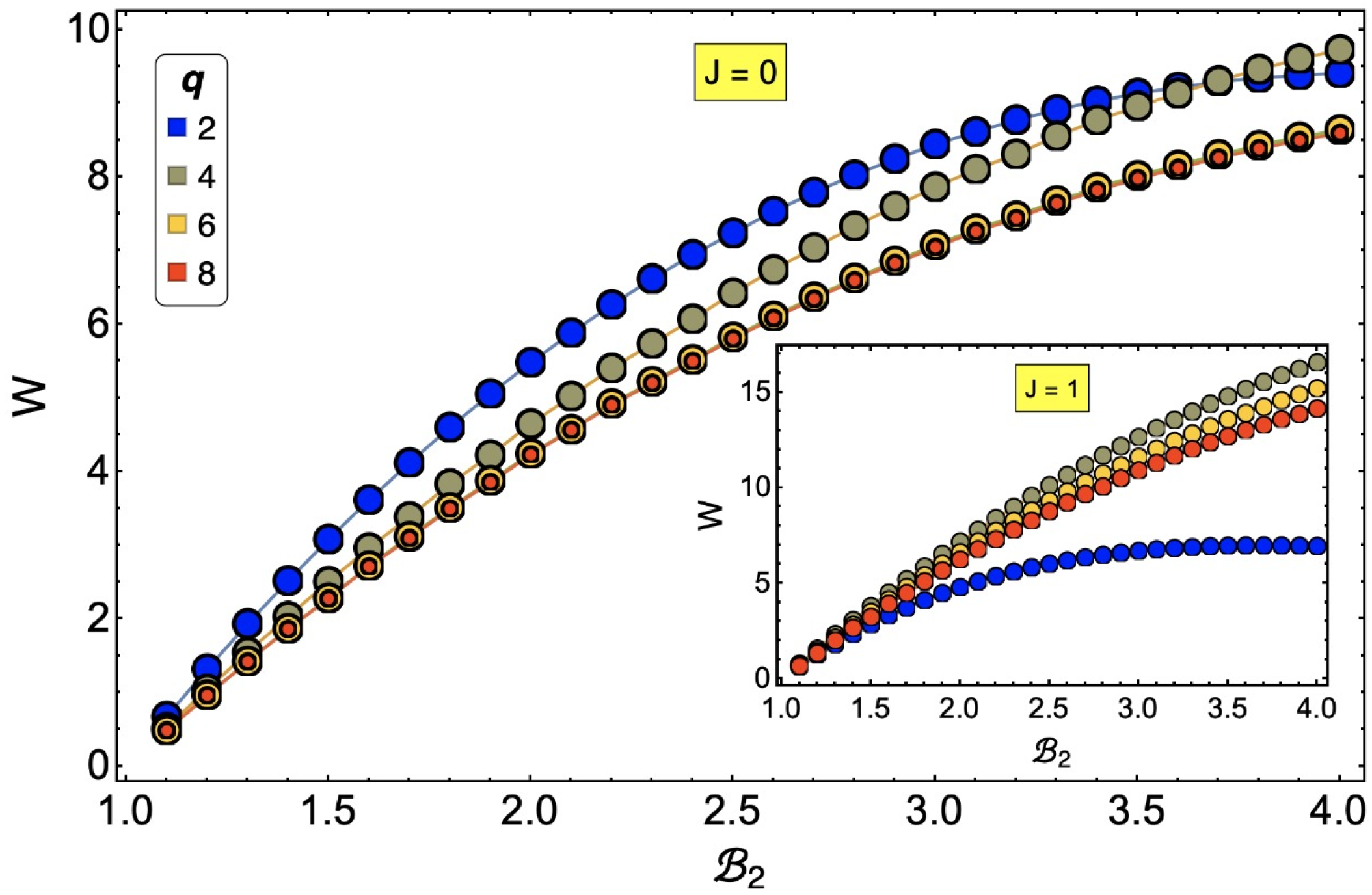1. Introduction
The Otto cycle, widely used by the automotive industry, is today one of the most studied cycles theoretically and experimentally in thermodynamics [
1,
2,
3,
4,
5,
6,
7,
8,
9,
10,
11,
12,
13,
14,
15,
16,
17,
18,
19,
20,
21,
22]. This is due to two fundamental reasons: The first is that the efficiency depends on the properties of the working substance, and the second is that its execution stages separate the contributions of work and heat [
23,
24]. The standard Otto cycle consists of two isochoric trajectories and two isentropic trajectories. In the case where the control parameter is the external magnetic field, the isochoric paths are constant magnetic field processes. In this context, the performance of various working substances operating under an Otto cycle where the control parameter corresponds to an external magnetic field has been studied, where we highlight quantum dots [
25], graphene quantum dots [
26], multiferroic chain [
27,
28], twisted bilayer grapehene [
29], and two-spin systems with the Dzyaloshinski–Moriya interaction [
30], among others.
On the other hand, the
q-state clock model is the discrete version of the famous 2D XY model [
31,
32,
33,
34], which is probably the most extensively studied example showing the Berezinskii–Kosterlitz–Thouless (BKT) transition in the presence of a frustrated quenched disordered phase [
35,
36,
37,
38,
39,
40]. The
q-state clock model is one of many magnetic models to mimic the thermodynamics of some materials, and it can be viewed as a classical Heisenberg spins model with very strong planar anisotropy [
31].
One way to characterize the phase transitions of the
q-clock state model is through the maxima obtained in the specific heat as a function of temperature. Each location of a maximum of the specific heat on the temperature axis will represent a value for a so-called
critical temperature. It has been shown [
35,
36,
37,
38,
39,
40] (in the absence of an external magnetic field) that for the
q-clock state model, values
(where
q represents the number of possible orientations that the spins can take), the specific heat presents two maxima. The first maximum corresponds to a transition from a ferromagnetic phase (FP) to a BKT phase, while the second maximum corresponds to a transition from BKT to a paramagnetic disordered phase (PP) [
31].
In this research, we propose to study the work and efficiency of an Otto engine whose working substance is an interacting spin system based on the well-known q-state clock model. For this purpose, a complete analysis of the thermodynamics of small lattice systems will be made by exact calculations, and the mean-field approximation will be used for large lattice sizes. Phase diagrams will be calculated for a correct analysis to establish the cycle’s operating range and what kind of transitions are involved. In addition, the effects of lattice size on the cycle performance are studied. In particular, for our simulations, it is found that the model with four spin degrees of freedom is the one with the best performance.
This article is organized in the following way: The next section describes the system.
Section 3 covers the calculations of thermodynamics.
Section 4 explains the model of the engine proposal.
Section 5 is devoted to the presentation of the phase diagram of the system.
Section 6 is oriented to understand where the Otto engine simulations are positioned in the phase diagram of the proposed working substance.
Section 7 presents the results and their discussion, and finally,
Section 8 includes the main conclusions of this paper.
5. Phase Diagram
The maximum values of the heat capacity define phases of magnetic order. Therefore, a qualitative analysis of the behavior of the specific heat concerning temperature and the external magnetic field is proposed. We can see an example of the maxima in specific heat for a
lattice for the exact evaluation in the cases of
and
in
Figure 6a,b and for
and
in
Figure 6c,d, respectively. In these figures, it can be clearly seen that for
, the specific heat has two maxima, which is indicative of a double phase transition. However, this two peaks observed for
and
(
Figure 6c,d, respectively) shift to higher temperatures as the external magnetic field increases. This behavior is easily explained by the external field favoring ordered phases (FM and BKT) over disordered ones, and therefore, the transition temperatures increase with the strength of the external field [
31]. These results of thermodynamics observable are consistent with those reported in previous work in the literature [
31,
32,
33,
34].
Obtaining the curve representing the boundary between phases is based on maximizing the heat capacity for a given field and saving the pair of points
for each model. In
Figure 7a,b, we visualize the phase diagram for
and
, while for
Figure 7c,d, we show the phase diagram for
and
, respectively. Both figures show calculations with exact approximation for a small
lattice.
Figure 7a,b represent the specific heat maxima presented in
Figure 6a,b showing its FP and PP phases as expected for these values of
q, whereas
Figure 7c,d visualize the BKT phase for
and
in accordance with the specific heat figures shown in
Figure 6c,d.
In
Figure 7a, for the Ising model (
), we notice that under the dotted curve, we are in an ordered FP region (blue zone). As the temperature increases, the spins start to disorder until reaching PP (red zone). For
(
Figure 7b), we notice a similar transition, with the difference of needing lower temperatures to achieve disorder. The phase diagram for
and
presented in
Figure 7c and
Figure 7d, respectively, shows three clear phases for
, while for
, all three phases are present only up to an external magnetic field close to
. For higher magnetic fields, in the case of
, only a transition from FP to PP is present. This last characteristic is in coherence with the specific heat plots shown in
Figure 6c where we see that for fields higher than
, in this case,
,
, and
shown in that figure (lemon-green, yellow, and orange line, respectively), a peak in specific heat is lost compared to that shown for
(blue line) and
(purple line). Consequently, we only have a transition from FP to PP type as the temperature increases for this case studied.
6. Cycle Reservoirs
Having two phase transitions for
in the model, positioning the reservoirs deserves a little analysis in favor of understanding how many transitions we will deal with throughout the cycle. For this, it is useful to unify
Figure 7a–d and plot the location of the cold and hot reservoirs as a point and a horizontal line on that figure, respectively. This is presented in
Figure 8, where we observe that the selection of the cold (point
of the cycle) and hot (point
of the cycle) reservoir for our simulations is given by the points
The selection of these points is based on satisfying three criteria:
(i) The cold reservoir must have an entropy whose value is distinguishable to the accuracy of numerical calculations in order to solve the first adiabatic condition given by Equation (
16).
(ii) At least one phase transition must be included in the cycle.
(iii) Although the study is initiated with the intention that all models, faced with the same hot reservoir, transit between FP and PP, the FP region of corresponds to a zone with low entropy, which would generate problems associated with the first point of the criteria under discussion. Consequently, we place the cold reservoir in a BKT phase for this case. As we have discussed above, may present a double phase transition for magnetic field values , so we select a cold reservoir that considers dominant only the region of a single maximum in the specific heat for that value of q. In this case, it is a zone where only one kind of transition of type BKT to PP exists, which occurs for . This is done to have two study cases with FP to PP transitions and two with BKT to PP transitions. In summary, in the results shown in the following section, the proposed magnetic Otto engine for and will transit between phases FP and PP, while for and , it will transit between phases BKT and PP.
Finally, it is essential to mention that as the lattice size increases, our results indicate that the critical temperatures increase for all q values studied, which implies that the FP was becoming more prominent. However, with the points selected for the cycle operation, we conserve the types of transitions for each value of q that can occur in the engine’s execution.
7. Results and Discussion
We will first analyze the behavior of the work and motor efficiency (given by Equation (
22) and Equation (
21) respectively) in a
lattice with the exact and mean-field approximation for
, and 8. This analysis is presented in
Figure 9, wherein panel (a), the total work is presented and (b) shows the system efficiency. Both plots are shown as a function of the variable magnetic field in the system corresponding to
from value 1.1 to 4. For the total work extraction presented in
Figure 9a, we note that the
curve (Ising model, blue-colored curves) has the worst performance. The
, and 8 curves decrease the total work extraction obtained as
q increases, with the
curve (lemon-green-colored curves) having the highest work. It is important to note that we noticed a similar result between the exact (solid lines) and mean-field methods (dashed lines), which indicates the consistency of the presented calculations. These differences between the approximations to obtain the thermodynamics of the system decrease as
q grows. For
and
, the exact method performs better than the mean-field results. The above mentioned is reversed for
and
, obtaining higher total work than the mean-field approximation. In the case of efficiency,
Figure 9b shows that the
case still presents the worst performance of the cases analyzed. It is also the one that present the largest difference between the exact and mean-field calculations. From
Figure 9b, we observe that the efficiency for
is the highest of all cases, which is followed by that for
, then
, and finally
. It is important to note that the differences between the efficiencies of the
, and 8 cases are relatively small. Consequently, if we think of the best performance of the machine that can be intuited from
, this will correspond to the
case.
The behavior of the efficiency for the exact case in the
lattice can be understood if we analyze the difference between the heat input (
given by Equation (
17)) and the heat output (
given by Equation (
20)) divided by
due to the fact that the efficiency can be written as
In
Figure 10, it can be seen that the ratio between
and
is not as significant for
as it is for the other values of
q studied, with the largest differences between
and
being
and
. Consequently, a lower efficiency is expected for the Ising model (
) with the parameters selected in the study.
In order to see the effects of lattice size on total work and efficiency, we propose to study with the mean-field approximation the case of a lattice of size
(for all values of q), where the number of effective neighbors,
is already close to the value four and the approximation is more robust. These results are shown in
Figure 11a,b, wherein (a) we show the total work and (b) the efficiency of the system in comparison in a
lattice. For the results to be comparable in
Figure 11a, we must speak of work per spin, i.e., divide the total work obtained by the number of spins in the lattice. The first result we can appreciate in work per spin is that the larger the lattice, the smaller the amount of extraction work obtained from the cycle for any value of
q. The
case is still the lowest total work and the most significant difference between the lattice sizes studied. In addition,
continues to show the highest work extraction. In addition, for a large
lattice, we observe that there are no significant differences at low magnetic fields (up to about
) in the efficiency of the
, and 8 cases.
We can establish a quantitative relationship between the results obtained for the total work and the location of the operating zone of the cycle by looking at the phase diagrams in
Figure 7. If we first analyze the FP–PP-type transitions, corresponding to the
and
cases (panels (a) and (b) of
Figure 7), we observe that the ferromagnetic phase involved in the cycle will be larger than that of the
case, where the preponderant phase will be the PP. Comparing the work of
and
, it is already known that
presents a higher work than the case of
. If we focus on the BKT–PP-type transitions from
Figure 7, we notice that the BKT zone of
(panel (c) of
Figure 7) involved in the cycle will be smaller than that of
(panel (d) of
Figure 7). If we now compare only the work of
and
, the case of
extracts more work than
. This simple comparison of results is an indication that the total work will be more significant (with the same operating parameters) when we have a smaller portion of the cycle in a sorted zone. In addition, our results indicate that a FP–PP-type transition is more beneficial than a BKT–PP-type transition for the performance of the proposed magnetic motor when a small portion of the cycle is positioned in an FP zone.
The result of why
in the selected parameter region is the best performing can be analyzed through the
W in each of the adiabatic stages of the cycle. We notice in
Figure 12a, which presents the work
as a function of
, that the differences between each of the curves for the different values of
q are minor being the smallest the case of
(blue line) and
(lemon-green line). This is mainly because, according to the phase diagram in
Figure 7a,b, the process takes place almost entirely in an FP. While in the case of
and
, there is a mixture between the FP and BKT phases. However, when we analyze the work
presented in panel (b) of
Figure 12, we realize that almost all work values for different values of
q are the same except for
, which shows (in absolute value) a more significant difference concerning the previous ones. The
process is always carried out in a paramagnetic zone for all
q, as in the case
, where point
of the cycle is closer to the transition between the phases. In energetic terms, for the
q-clock model, being located close to the transition represents higher internal energy (in absolute value). Therefore, the energy difference will be more considerable between points
and
. As the work at this stage is negative, if
is large, the smaller the total work of the cycle will be.
Finally, we would like to mention that the effect of the
J parameter on the cycle is not trivial.
J plays a transcendental role in the critical temperatures and, therefore, in the phase diagram. In the extreme case of
(a free spin system), the work substance for cases with spin degrees of freedom
, and 8 reduces the total work, while for
, the opposite is true (see
Figure 13). This is because in the region of operation we selected for our study, it is more difficult (energetically) to change the spin orientation for an Ising-type model than for models with more degrees of freedom. However, when we increase the value of
q in the selected region of temperature and field, the exchange favors the visitation of the different states of the
q-clock model, thus reducing the amount of work required to perform the adiabatic process from
to
. Additionally, we note that for the case
,
and
show the same extraction work. This is since for larger values of
q, the difference between the internal energies (only for
) are smaller and smaller; therefore, a convergence in the calculation of the total work in the cycle is expected.
8. Conclusions
In this work, we have addressed the possibility of operating an Otto engine whose working substance is an interacting spin system corresponding to the q-state clock model. For small lattice systems, we have calculated and analyzed the thermodynamics of the system exactly by obtaining all the accessible microstates of the system, while for larger lattices, we have performed the calculations through the mean-field approximation. The working substance used presents one or two phase transitions depending on the degree of freedom of the spin; therefore, the selection of the operating range of the motor cannot be arbitrarily selected, and in our study, we have placed it for the Ising model and from an ordered phase (ferromagnetic phase) to a disordered phase (paramagnetic phase), while for and , it is from a vortex phase (BKT phase) to a disordered phase. The results for small-size lattices indicate that for the selected operating range, presents the best performance based on the extraction work and efficiency that can be obtained in the cycle, while the Ising model is the worst performer of all the cases analyzed. When the lattice size is increased, both the efficiency and spin work decrease, but the case is still the best-performing case. These reported results can be interpreted from the phase diagram of the working substance, which indicates that a smaller portion of the cycle in a ferromagnetic phase would allow a better total work output.
Our result of the optimal work and efficiency for the system with does not have a general reason. As the energies grow with temperature, it is convenient that the work window used in the Otto cycle includes a low entropy ordered zone, i.e., ferromagnetic phase and high entropy in a high-temperature, paramagnetic disordered phase, so that the energy differences make to be maximal. In our case, this occurs for , but if the window of the Otto cycle is varied, we can find that the work is maximized for another value of q.
This work is currently undergoing an extension in the context of an
endoreversible scenario in order to obtain the finite power output of the proposal machine [
41] considering, in addition, the anisotropy and dipolar interaction terms, both of which are fundamental in the accurate description of authentic materials.
